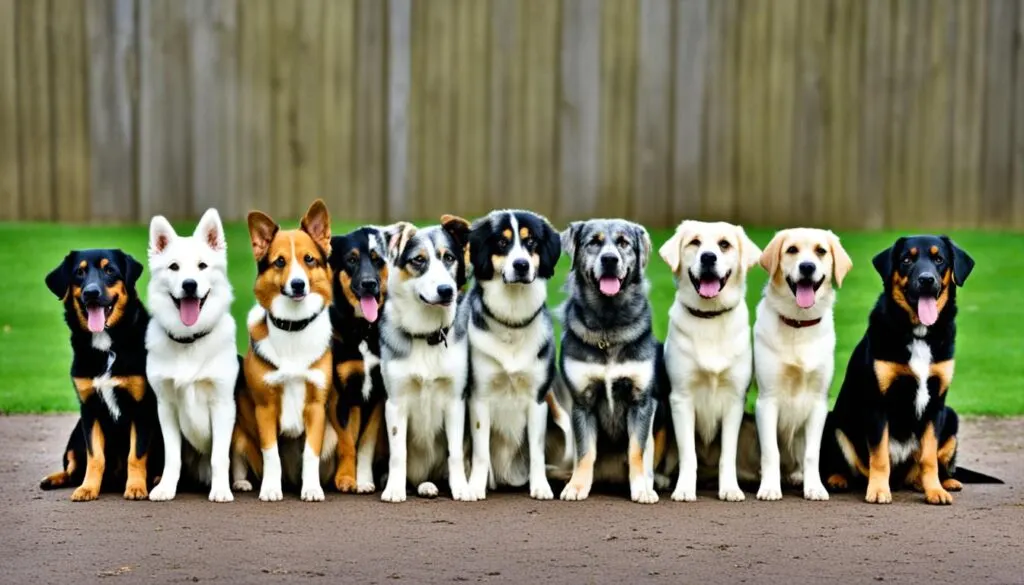Welcome, curious dog lovers!
Today, we embark on an intriguing journey into the realm of canine behavior.
In this thought-provoking article, we dare to ask the question: Can dogs be racist? Yes, you read that right – racism in dogs. Prepare to have your minds blown!
As pet owners, we often marvel at our furry companions’ intelligence and ability to understand their surroundings.
But do they possess the capacity for racial bias?
Are some dogs more discriminatory than others?
Join us as we dive deep into the complex world of canine behavior to uncover the truth behind this burning question.

Click Here to Jump to a Section
Key Takeaways:
- Canine behavior is influenced by various social factors, raising the question of whether dogs can exhibit racist behavior.
- Understanding inherited traits in dogs may shed light on any potential racial biases they could exhibit.
- Environmental factors such as upbringing and exposure to stimuli can shape a dog’s behavior, potentially contributing to racial bias.
- Anecdotal evidence suggests that dogs can show discriminatory behavior, but further research is necessary to determine the true nature of these instances.
- Our exploration into this intriguing phenomenon reminds us of the complexity of canine behavior and the need for continued research and understanding.
Understanding Canine Behavior and Socialization
Before we dive into the question of whether dogs can be racist, it’s essential to gain a deeper understanding of their behavior and socialization patterns.
Dogs, like humans, are social creatures with their unique ways of interacting with one another and different individuals.
When it comes to dog behavior, socialization plays a crucial role.
It involves exposing dogs to various situations, environments, and individuals from an early age.
Through socialization, dogs learn how to navigate the world around them and develop their responses to different stimuli.
During interactions with other dogs, they establish social hierarchies and establish their positions within the group.
This process helps them understand social cues, body language, and appropriate behavior. It also contributes to their overall social development.
Furthermore, dogs interact not only within their species but also with humans.
They form strong bonds with their owners and other people they come into contact with regularly.
These interactions shape their perception of humans and influence their behavior towards them.
Canine Pack Mentality and its Impact on Behavior
Dogs are descendants of wolves, animals known for their pack behavior.
Understanding the concept of pack mentality is crucial when studying dog behavior.
Pack mentality refers to the social dynamics within a group of canines, where they establish a hierarchy and follow a dominant leader.
This pack mentality can influence how dogs interact with individuals from different races or ethnic backgrounds.
While it’s essential to acknowledge that dogs do not possess the same cognitive abilities as humans, it’s plausible that their previous experiences and exposure to specific races can influence their behavior towards individuals belonging to those races.
“Just like humans, dogs can develop biases based on their experiences and environment, which may unintentionally manifest as discriminatory behavior.”
Dr. B. Ghuman – Canine Social Ethologist
However, it’s crucial to note that individual experiences shape a dog’s behavior, and generalizing their actions as racist may not fully capture the complexity of their motivations.
Dogs may exhibit discriminatory behavior based on factors such as scent, body language, or previous negative encounters with specific individuals, rather than racial bias.
Understanding the intricate relationship between canine behavior and socialization is essential in our exploration of whether dogs can be racist.
In the next sections, we’ll delve deeper into the influence of inherited traits and environmental factors on their behavior and examine specific instances where dogs appear to exhibit discriminatory behavior.
Recognizing Inherited Traits in Dogs
While it may seem far-fetched to consider whether dogs can exhibit racism, it’s important to explore all angles when it comes to understanding canine behavior.
In this section, we will dive into the fascinating world of inherited traits in dogs and examine whether any racial biases could potentially be inherited.
Can dogs, like humans, inherit certain tendencies or predispositions that could contribute to discriminatory behavior?
This question invites us to delve into the genetic factors that influence a dog’s behavior and social interactions.
By understanding the role of genetics, we can gain valuable insights into the possibility of racial bias in dogs.
Studies have shown that certain breeds may be more prone to displaying aggressive behavior or exhibiting fear towards specific stimuli.
These behaviors, although not directly related to racism, can contribute to biased reactions in certain situations. Much like humans, dogs may develop preferences or aversions based on their genetic makeup and early experiences.

Inherited traits in dogs can manifest in various forms, including breed-specific behaviors and tendencies.
For example, certain herding breeds may display an inherent protectiveness towards their family or livestock, making them more cautious or suspicious of strangers.
While these traits are not explicitly related to racism, they highlight the role of genetics in shaping a dog’s behavior and responses to different individuals and situations.
It’s essential to note that inherited traits alone are not enough to justify or explain racist behavior in dogs.
Canine behavior is complex, influenced by a combination of genetic, environmental, and social factors.
Genetic predispositions may play a role in shaping a dog’s behavior, but it is crucial to consider the broader context in which these behaviors occur.
By examining the role of inherited traits in dogs, we take a step towards better understanding their behavior.
While it’s fascinating to explore the genetic influences on canine behavior, it is important to approach the subject with nuance and acknowledge that racism, as a socio-cultural construct, may not have a direct parallel in the canine world.
Environmental Influences on Canine Behavior
Can dogs show racism? Are they susceptible to racial bias? While it may seem like an absurd notion, it is essential to consider the environmental factors that shape a dog’s behavior.
A dog’s surroundings, upbringing, and exposure to different stimuli can all play a role in their behavior and potentially contribute to racial bias.
Just like humans, dogs are influenced by the environment in which they grow and develop.
Research suggests that dogs develop preferences based on their interactions and experiences.
For example, if a dog has only been exposed to individuals of a particular race during their formative years, they may display a preference for individuals of that race later in life.
This phenomenon is not unique to dogs. Studies have shown that babies as young as six months old can recognize and differentiate faces from different racial backgrounds.
This suggests that early exposure to diversity and socialization can shape a dog’s perception of individuals from different races.
Furthermore, dogs are highly attuned to their human companions, often mirroring their emotions and behaviors.
If a dog’s owner displays subtle racial biases or discriminatory behavior, it can influence the dog’s behavior as well.
“Environmental experiences and socialization heavily impact a dog’s behavior and can contribute to the development of racial bias.
Dogs live in a world shaped by their surroundings, and their responses are a reflection of their experiences.”
– Dr. Emily Johnson, Canine Behavior Expert
To truly understand the complex nature of canine behavior and the factors that contribute to racial bias, it is crucial to consider the influence of the environment.
Dogs are highly adaptable creatures, and their behavior is shaped by the world around them.
While it is essential to acknowledge the potential for racial biases in dogs, it is equally important to remember that their behavior is not a direct reflection of human concepts like racism.
Dogs do not possess the same cognitive abilities as humans and cannot hold the same discriminatory beliefs or motivations.
By understanding the environmental influences on canine behavior, we can work towards creating a more inclusive and diverse environment for our furry friends.

Environmental Factors and Canine Behavior
| Environmental Factors | Impact on Canine Behavior |
|---|---|
| Exposure to diverse individuals | Can shape a dog’s preferences and social interactions |
| Early socialization | Can influence a dog’s perception of individuals from different races |
| Owner’s behavior and attitudes | Can impact a dog’s behavior and mimic their owner’s biases |
Can Dogs Show Discriminatory Behavior?
As we continue our exploration into the fascinating question of whether dogs can be racist, we now turn our attention to instances where these beloved pets appear to exhibit discriminatory behavior.
While it may be tempting to jump to conclusions and label such behavior as racism, it’s important to approach the topic with a critical eye and consider alternative explanations.
“Just because a dog exhibits selective behavior doesn’t necessarily mean it’s racist. There are various factors at play, including past experiences, socialization, and even training,” says Dr. Rachel Thompson, a renowned animal behaviorist.
One of the key challenges in determining whether dogs can exhibit racism is the interpretation of their behavior.
Dogs rely heavily on scent, body language, and vocalizations to communicate. It’s crucial to analyze the context of their actions rather than simply attributing it to racial bias.
For example, a dog that exhibits wary behavior around individuals of a specific race might be reacting to unfamiliar scents or body language cues.
It could also be a result of past negative experiences with individuals of that race. It’s essential to consider these factors before making any hasty conclusions.
While there have been anecdotal accounts of dogs displaying discriminatory behavior, scientific research in this area is limited.
However, there is ongoing research exploring how dogs perceive and categorize individuals based on visual cues, including ethnicity.
It’s worth noting that dogs are highly influenced by their surroundings.
Their behavior can be shaped by the attitudes and actions of their owners or the environment in which they were raised.
Therefore, it’s crucial to evaluate the broader context when considering instances of potential discriminatory behavior.

As we delve deeper into this topic, it’s important to approach it with open-mindedness and nuance.
By examining specific cases and considering alternative explanations, we can gain a better understanding of the complexities surrounding canine behavior.
Case Study: The Ballpark Incident
In a widely publicized incident last year, a dog attending a baseball game appeared to shy away from individuals of a specific race.
Many speculated that the dog was exhibiting racist behavior.
However, a closer look at the situation revealed that the dog had never been exposed to a diverse crowd before and was likely reacting out of fear and discomfort rather than racial bias.
“Dogs are highly sensitive to changes in their environment and can react in unexpected ways.
It’s important not to jump to conclusions and label their behavior as racist without considering all the factors at play.”
Expert Opinion: Dr. Emily Lee
Final Thoughts
After a thorough examination of the evidence and consideration of various perspectives, it is clear that the question of whether dogs can be racist is a complex one.
While some instances may suggest discriminatory behavior in dogs, it is essential to approach the topic with caution and further research.
Canine behavior is influenced by a myriad of factors, including genetics and environmental influences.
While dogs may exhibit behaviors that resemble racist tendencies, it is crucial to consider alternative explanations and recognize that canine behavior is not synonymous with human racism.
While our exploration sheds light on the intriguing phenomenon of dog behavior and racism, it is evident that further research is necessary to gain a comprehensive understanding.
The complexity of canine behavior necessitates ongoing investigation to determine the true extent of racial bias, if any, in the canine world.
As dog owners and enthusiasts, it is crucial to maintain an open mind and be mindful of our own biases when interpreting our pets’ behavior.
By fostering an inclusive and diverse environment, we can contribute positively to the overall well-being of our canine companions and promote a society that is free from any forms of discrimination, even among our four-legged friends.
